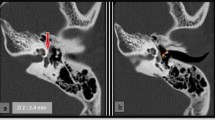Abstract
Purpose
To clarify the anatomical distribution of otosclerotic loci in otosclerosis.
Methods
Ninety-five patients with surgically confirmed uni- or bilateral otosclerosis were enrolled into the study. Hypodense areas observed in the otic capsule by high-resolution computed tomography (HRCT) were defined as otosclerotic loci. The location and number of lesions were examined, and the probability of lesion overlap and correlation with age/hearing parameters (air and bone conduction threshold, air-bone gaps) were tested.
Results
Otosclerotic loci were confirmed by HRCT in 77 out of 115 operated ears. The three commonly affected sites were the anterior part of the oval window (ant-OW), anterior part of the internal auditory canal (ant-IAC), and pericochlear area (PCochA), with lesions detected in 96.1%, 46.8%, and 26.0% of ears, respectively. Only the ant-OW area was affected in 48.1% of the ears; the ant-IAC in 3.9%; and PCochA in none with significant differences (p < 0.01). The ant-OW lesions preferentially overlapped with ant-IAC (44.6%) than PCochA lesions (27.0%) (p < 0.05). Among double sites diseases, triple sites diseases occurred more commonly in the ant-OW + PCochA group (80%) than ant-OW + ant-IAC group (48.5%) (p < 0.05). There was no correlation between a number of lesions and age/hearing parameters.
Conclusions
Based on the probability of lesion overlap, otosclerotic lesions may initiate at ant-OW followed by ant-IAC and later PCochA. Although the number of lesions showed no immediate correlation with hearing level or age, anatomical stage of the disease estimated by the location and the number of otosclerotic loci could be useful in predicting the future hearing status.

Similar content being viewed by others
References
McKenna MJ, Merchant SN (2010) Disorders of bone. In: Merchant SN, Nadol JB (eds) Schuknecht’s pathology of the ear. People’s Medical Pub. House-USA Inc., Shelton, pp 716–719
Chole RA, McKenna M (2001) Basic science review: pathophysiology of otosclerosis. Otol Neurotol 22:249–257
Wegner I, van Waes AMA, Bittermann AJ et al (2016) A systematic review of the diagnostic value of CT imaging in diagnosing otosclerosis. Otol Neurotol 37:9–15
Yamashita K, Yoshiura T, Hiwatashi A et al (2014) The radiological diagnosis of fenestral otosclerosis: the utility of histogram analysis using multidetector row CT. Eur Arch Otorhinolaryngol 271:3277–3282
Redfors YD, Gröndahl HG, Hellgren J et al (2012) Otosclerosis: anatomy and pathology in the temporal bone assessed by multi-slice and cone-beam CT. Otol Neurotol 33:922–927
Marx M, Lagleyre S, Escudé B et al (2011) Correlations between CT scan findings and hearing thresholds in otosclerosis. Acta Otolaryngol 131:351–357
Lagleyre S, Sorrentino T, Calmels MN et al (2009) Reliability of high-resolution CT scan in diagnosis of otosclerosis. Otol Neurotol 30:1152–1159
Lee TC, Aviv RI, Chen JM et al (2009) CT grading of otosclerosis. Am J Neuroradiol 30:1435–1439
Bozorg Grayeli A, Saint Yrieix C, Imauchi Y et al (2004) Temporal bone density measurements using CT in otosclerosis. Acta Otolaryngol 124:1136–1140
Kiyomizu K, Tono T, Yang D et al (2004) Correlation of CT analysis and audiometry in Japanese otosclerosis. Auris Nasus Larynx 31:125–129
Quesnel AM, Moonis G, Appel J et al (2013) Correlation of computed tomography with histopathology in otosclerosis. Otol Neurotol 34:22–28
Shin YJ, Fraysse B, Deguine O et al (2001) Sensorineural hearing loss and otosclerosis: a clinical and radiologic survey of 437 cases. Acta Otolaryngol 121:200–204
Valvassori GE (1993) Imaging of otosclerosis. Otolaryngol Clin N Am 26:359–371
Zhu MM, Sha Y, Zhuang PY et al (2010) Relationship between high-resolution computed tomography densitometry and audiometry in otosclerosis. Auris Nasus Larynx 37:669–675
Vicente Ade O, Yamashita HK, Albernaz PL et al (2006) Computed tomography in the diagnosis of otosclerosis. Otolaryngol Head Neck Surg 134:685–692
Benjamin J, Frank B, Anne-Michelle N et al (2010) Computed tomography and otosclerosis: a practical method to correlate the site affected to hearing loss. Ann Otol Rhinol Laryngol 119:789–794
Naumann IC, Porcellini B, Fisch U (2005) Otosclerosis: incidence of positive findings on high-resolution computed tomography and their correlation to audiological test data. Ann Otol Rhinol Laryngol 114:709–716
Hueb MM, Goycoolea MV, Paparella MM (1991) Otosclerosis: the University of Minnesota temporal bone collection. Otolaryngol Head Neck Surg 105:396–405
Schuknecht HF, Barber W (1985) Histologic variants in otosclerosis. Laryngoscope 95:1307–1317
Markou K, Stavrakas M, Karkos P et al (2016) Juvenile otosclerosis: a case presentation and review of the literature. Case Rep 2016:bcr2015214232
Gristwood RE, Venables WN (1983) Pregnancy and otosclerosis. Clin Otolaryngol Allied Sci 8:205–210
Author information
Authors and Affiliations
Corresponding author
Ethics declarations
Conflict of interest
The authors declare that they have no conflict of interest.
Ethical approval
This study was approved by the IRB of Niigata University Medical and Dental Hospital (#2017-0271). All procedures performed in studies involving human participants were in accordance with the ethical standards of the institutional and/or national research committee and with the 1964 Helsinki declaration and its later amendments or comparable ethical standards.
Informed consent
Informed consent was obtained from all individual participants included in the study.
Additional information
Publisher’s Note
Springer Nature remains neutral with regard to jurisdictional claims in published maps and institutional affiliations.
Rights and permissions
About this article
Cite this article
Yagi, C., Morita, Y., Takahashi, K. et al. Otosclerosis: anatomical distribution of otosclerotic loci analyzed by high-resolution computed tomography. Eur Arch Otorhinolaryngol 276, 1335–1340 (2019). https://doi.org/10.1007/s00405-019-05385-w
Received:
Accepted:
Published:
Issue Date:
DOI: https://doi.org/10.1007/s00405-019-05385-w




